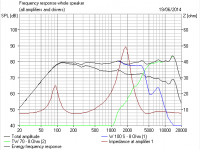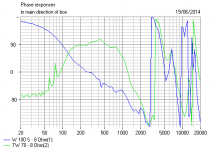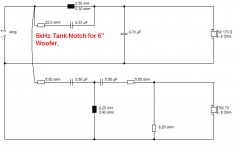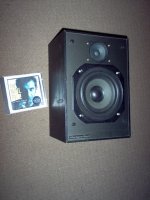I always like it when people publish a crossover. It's brave. And the crossover IMO makes more difference to the sound than anything. 
How 4" woofers work is they break up badly around 7-8kHz. This is a harsh sound. It's a simple matter of geometric distance from the voicecoil to the edge surround.
You have very shallow filters there. It's only about 10db down at 8kHz. So I'd guess that speaker sounds a bit harsh. If it was me, I'd try crossing it more steeply and lower. Until we run into the point where the tweeter is distorting. See, it's a compromise.
The fella who did the Canzonetta's used a much bigger coil (2mH) and capacitor on the bass. He also did a much lower tweeter crossover. Your fussier Vifa tweeter might need a third order to avoid distorting, but I think it's worth trying.
It would sound bassier and less harsh at high volume. What do you think? You have this speaker in front of you, after all. A good design takes months of tuning IMO.
How 4" woofers work is they break up badly around 7-8kHz. This is a harsh sound. It's a simple matter of geometric distance from the voicecoil to the edge surround.
You have very shallow filters there. It's only about 10db down at 8kHz. So I'd guess that speaker sounds a bit harsh. If it was me, I'd try crossing it more steeply and lower. Until we run into the point where the tweeter is distorting. See, it's a compromise.
The fella who did the Canzonetta's used a much bigger coil (2mH) and capacitor on the bass. He also did a much lower tweeter crossover. Your fussier Vifa tweeter might need a third order to avoid distorting, but I think it's worth trying.
It would sound bassier and less harsh at high volume. What do you think? You have this speaker in front of you, after all. A good design takes months of tuning IMO.
I don't have a whole lot of experience with this, so take this with a healthy handful of salt.
Breakup doesn't seem to be a problem at any reasonable listening level. Two things to note: these are 3" drivers, regardless of what the specs say. The flange is huge. Secondly, a guy over on the PE boards measured them up (RS100P-8 Measurements), and HD has no super significant peaks (if I'm reading that correctly). Even the nearfield 2nd order at 10khz is down 30db.
I chose the high xo for a few reasons. The first was because I wanted to keep the xo a little outside of the vocal band. That way vocals (male especially) are only running through one driver and are therefore not subject to any of the xo's effects. This seems to work well - the tweet just takes care of sibilance.
The second was to keep the XT happy with a shallow XO. According to zaph's resources it really doesn't like having significant output below 1.5k or so.
Third; I'm a mechanical engineer, and I've found in my work that keeping things simple is massively important, even if it means less than ideal designs. Since I have little experience I figured the 4k XO was a safe play. It allows a real simple crossover with a high chance of success. By using very few components, and relying on the drivers to do most of the work, I can ensure that unintended effects are kept to a minimum. The only exception I've found is if you really know what you're doing. Simple is good.
As for listening impressions? Well, my old pair of badly designed speakers had a definite maximum volume, above which everything went totally to ****. They got super harsh and it was obvious. Those used 6" aluminum woofers with no attempt to suppress breakup.
These don't seem to have anything like that. I'm running them on a dayton 2.1 plate amp - active cross to a 10" sub at 85hz. In that configuration they play cleanly up until excursion gets out of control. There is no real jump (to my untrained ears) from clean to nasty, aside from horrid room effects.
I also ran them maxed out on a pyle PTA2, and they sucked up everything without flinching. It was actually pretty startling - that was outside so there were limited room effects and it really was very clean until I ran out of power.
It's all a little moot though. Without measuring equipment to show me what's going on I won't know what to listen for.
Alternately, I would love it if somebody nearby wants to have a listen and tell me what they think.
Breakup doesn't seem to be a problem at any reasonable listening level. Two things to note: these are 3" drivers, regardless of what the specs say. The flange is huge. Secondly, a guy over on the PE boards measured them up (RS100P-8 Measurements), and HD has no super significant peaks (if I'm reading that correctly). Even the nearfield 2nd order at 10khz is down 30db.
I chose the high xo for a few reasons. The first was because I wanted to keep the xo a little outside of the vocal band. That way vocals (male especially) are only running through one driver and are therefore not subject to any of the xo's effects. This seems to work well - the tweet just takes care of sibilance.
The second was to keep the XT happy with a shallow XO. According to zaph's resources it really doesn't like having significant output below 1.5k or so.
Third; I'm a mechanical engineer, and I've found in my work that keeping things simple is massively important, even if it means less than ideal designs. Since I have little experience I figured the 4k XO was a safe play. It allows a real simple crossover with a high chance of success. By using very few components, and relying on the drivers to do most of the work, I can ensure that unintended effects are kept to a minimum. The only exception I've found is if you really know what you're doing. Simple is good.
As for listening impressions? Well, my old pair of badly designed speakers had a definite maximum volume, above which everything went totally to ****. They got super harsh and it was obvious. Those used 6" aluminum woofers with no attempt to suppress breakup.
These don't seem to have anything like that. I'm running them on a dayton 2.1 plate amp - active cross to a 10" sub at 85hz. In that configuration they play cleanly up until excursion gets out of control. There is no real jump (to my untrained ears) from clean to nasty, aside from horrid room effects.
I also ran them maxed out on a pyle PTA2, and they sucked up everything without flinching. It was actually pretty startling - that was outside so there were limited room effects and it really was very clean until I ran out of power.
It's all a little moot though. Without measuring equipment to show me what's going on I won't know what to listen for.
Alternately, I would love it if somebody nearby wants to have a listen and tell me what they think.
Last edited:
Ah, you have a 10" subwoofer operating below 85Hz. It all starts to make sense!
I thought those speakers would sound bass light otherwise!
It's really not a million miles away from my three way Celestion Ditton 44 if you think about it. And that midbass is closer to a midrange than a woofer IMO.
But I still think a 3.5kHz crossover would make a lot more sense. You've definitely got cone breakup there. It sounds like MUSH on piano high notes. Try some Diana Krall on CD: Diana Krall _ I Remember You - YouTube
It should just sound exquisite! Every piano note separate. The rythym and timing perfect. It's what it's all about.
I thought those speakers would sound bass light otherwise!
It's really not a million miles away from my three way Celestion Ditton 44 if you think about it. And that midbass is closer to a midrange than a woofer IMO.
An externally hosted image should be here but it was not working when we last tested it.
But I still think a 3.5kHz crossover would make a lot more sense. You've definitely got cone breakup there. It sounds like MUSH on piano high notes. Try some Diana Krall on CD: Diana Krall _ I Remember You - YouTube
It should just sound exquisite! Every piano note separate. The rythym and timing perfect. It's what it's all about.
Ah, you have a 10" subwoofer operating below 85Hz. It all starts to make sense!
Yeah - I ported them to get flat extension through the intended crossover point, rather than for actual output. I think the RS100P would be great as a sealed midrange in a 3-way.
That said, at moderate listening levels they go surprisingly low, and can definitely stand by themselves as a pair of computer speakers or something.
I'll try some piano recordings that I know, but don't know that I will understand what to listen for.
The thing with cone break up is its severity varies quite considerably from driver to driver. All soft dome tweeters are operating in breakup throughout the top of their range and it doesn't screw them up. What's important is how the breakup manifests.
As can be seen from the measurements the break up is very well controlled. This can be seen in the impedance, distortion measurements and the impulse response. The impedance is free from wiggles or bumps and the impulse response decays quickly with a bit of high frequency ringing due to the hump at 10k. This shows a clear lack of energy storage indicating that the drivers breakup isn't particularly bad. What the distortion plot does show is a slight increase in the third harmonic, due to distortion amplification from the cone resonance at 10k. This 3rd harmonic hump hits at 3.5k and is fairly benign. This is why I would want to cross over at 3.5k as an even order xover at this frequency should be down by 6dB already and would go a long way towards suppressing the hump. This wont sound like the horrible mush/hash/harsh cone cry that glaringly obvious breakup can cause, more it could simply sound a tad unnatural on certain notes.
As can be seen from the measurements the break up is very well controlled. This can be seen in the impedance, distortion measurements and the impulse response. The impedance is free from wiggles or bumps and the impulse response decays quickly with a bit of high frequency ringing due to the hump at 10k. This shows a clear lack of energy storage indicating that the drivers breakup isn't particularly bad. What the distortion plot does show is a slight increase in the third harmonic, due to distortion amplification from the cone resonance at 10k. This 3rd harmonic hump hits at 3.5k and is fairly benign. This is why I would want to cross over at 3.5k as an even order xover at this frequency should be down by 6dB already and would go a long way towards suppressing the hump. This wont sound like the horrible mush/hash/harsh cone cry that glaringly obvious breakup can cause, more it could simply sound a tad unnatural on certain notes.
I've got to admit that the one measurement that IMO means anything about cone breakup is the PHASE. And I didn't see it in the measurements. 
You can see this 4" W 100 S - 8 Ohm is doing something horrible on frequency response at 7kHz. Bigger woofers do this lower.
But the smoking gun is actually the phase response when filtered. When it does that blue S-shaped kink at 6-8kHz, THAT is energy storage corresponding to a resonance. Ideally it is a straight line.
Time or group delay is the slope, FWIW. Keep this region well suppressed. Or it sounds horrible.
You can see this 4" W 100 S - 8 Ohm is doing something horrible on frequency response at 7kHz. Bigger woofers do this lower.
But the smoking gun is actually the phase response when filtered. When it does that blue S-shaped kink at 6-8kHz, THAT is energy storage corresponding to a resonance. Ideally it is a straight line.
Time or group delay is the slope, FWIW. Keep this region well suppressed. Or it sounds horrible.
Attachments
Last edited:
Smoothness doesn't mean a thing. Tweeters look smooth and hide a load of phase horrors. The 4" speaker has a resonance around 7-8khz just because of the wave going from the voicecoil to the edge hitting half a wavelength.
I know how to notch a speaker resonance as well as the next man, 5th Element. And it looks good on paper.
I'm uneasy about it though, because I don't think these breakup things are exactly linear when you turn the volume up.
http://www.klippel.de/fileadmin/klippel/Files/Know_How/Literature/Papers/KLIPPEL_Cone_Vibration_Poster.pdf
I do it when I have to. But I prefer some simple rolloff.
Sorry, Sniper, we are probably going over your head here.
I know how to notch a speaker resonance as well as the next man, 5th Element. And it looks good on paper.
I'm uneasy about it though, because I don't think these breakup things are exactly linear when you turn the volume up.
http://www.klippel.de/fileadmin/klippel/Files/Know_How/Literature/Papers/KLIPPEL_Cone_Vibration_Poster.pdf
I do it when I have to. But I prefer some simple rolloff.
Sorry, Sniper, we are probably going over your head here.
Attachments
Last edited:
Nope, not at all. I don't know much about speakers as a system (and specifically what to listen for) but I'm totally with you with regards to mechanical and electrical vibrations and resonances. 
It's really the quality and magnitude of the effects that I don't have a feel for. That's the type of thing you can only learn after a lot of time correlating qualitative experience and quantitative measurement.
It's been quite interesting to just post something and let you guys hash it out. I suspect it wouldn't matter if what I posted was just total gibberish, as long as it provided a starting point for a discussion.
It's really the quality and magnitude of the effects that I don't have a feel for. That's the type of thing you can only learn after a lot of time correlating qualitative experience and quantitative measurement.
It's been quite interesting to just post something and let you guys hash it out. I suspect it wouldn't matter if what I posted was just total gibberish, as long as it provided a starting point for a discussion.
As far as I understand it, as loudspeakers are minimum phase the phase response of the driver + filter follows the frequency response exactly. Maybe not mirroring it exactly, but follows it mathematically. Ergo, if you've got a kink in the phase response it's because you've got a kink in the frequency response.
One day I might be able to go back to uni and learn exactly what all this means at the fundamental level, but so far I'll make do with what I've got. Having said that I have no idea what course you'd need to do to learn all that stuff.
One day I might be able to go back to uni and learn exactly what all this means at the fundamental level, but so far I'll make do with what I've got. Having said that I have no idea what course you'd need to do to learn all that stuff.
Having said that I have no idea what course you'd need to do to learn all that stuff.
Signals, signal processing, or maybe control theory.
Not my schtick, but i recently worked with a guy who specialized in analog signal processing. This was all right up his alley.
Last edited:
As it goes, I did signal processing at college. Good stuff.
It's all about the process. I hang round here whilst building speakers. Guys like 5th element really make me focus, whilst behaving impeccably! Kudos E5!
TBH, this forum splits between support for our European Mr. Troels Gravesen and U.S. superstar Mr. Zaph. Of course there are others.
Personally, I am bored to high heaven with talk of Zaph's Linkwitz Riley 4th. order and low crossover filters. Give me lovely SEAS drive units fresh from the Fjords of Norway any day with nice high crossovers that keep the drivers in their comfort zone.
But I digress. I can officially announce the greatest DIY speaker in the World right now.
No, surprisingly it's not my new filter for the Sony E44.
It's this:
3-Way Classic
Lovely! That's really as good as it gets. What more do you need to know?
It's all about the process. I hang round here whilst building speakers. Guys like 5th element really make me focus, whilst behaving impeccably! Kudos E5!
TBH, this forum splits between support for our European Mr. Troels Gravesen and U.S. superstar Mr. Zaph. Of course there are others.
Personally, I am bored to high heaven with talk of Zaph's Linkwitz Riley 4th. order and low crossover filters. Give me lovely SEAS drive units fresh from the Fjords of Norway any day with nice high crossovers that keep the drivers in their comfort zone.
But I digress. I can officially announce the greatest DIY speaker in the World right now.
No, surprisingly it's not my new filter for the Sony E44.
An externally hosted image should be here but it was not working when we last tested it.
It's this:
3-Way Classic
Lovely! That's really as good as it gets. What more do you need to know?
Seems to me that while steep filters could be cool and all, they would be much less tolerant of error due to tolerance stackup and aggressiveness. Would a filter taller than 4th order even be practical on anything but a case-by-case basis?
Not to mention the cost...
I checked this crossover's modeled response at the tolerance limits of my components, and it seemed OK, but i also modeled some other configurations for fun and they tended to become rapidly infeasible with normal components.
Not to mention the cost...
I checked this crossover's modeled response at the tolerance limits of my components, and it seemed OK, but i also modeled some other configurations for fun and they tended to become rapidly infeasible with normal components.
Last edited:
That is one of Troels' better designs and probably my favourite of his too.
My only gripe with the guy is that he could easily place tweeters closer to the midrange drivers in most of his designs and tends to use xover frequencies that are too high for the drivers used.
I understand the allure of using higher xover frequencies but only if the off axis response isn't going to deteriorate because of it and only if the drivers distortion profile can support it too. There is no excuse for not mounting the tweeter and woofer/mid as close together as possible imo.
I think the boredom with Zaph is simply because he's been inactive for so long and if he had been producing lots of products and different design types at that, we'd probably see a nice three way more along the lines of what you'd like.
Something like an OX19 tweeter, a SS 10F and an SB acoustics paper something or other on the bass.
My only gripe with the guy is that he could easily place tweeters closer to the midrange drivers in most of his designs and tends to use xover frequencies that are too high for the drivers used.
I understand the allure of using higher xover frequencies but only if the off axis response isn't going to deteriorate because of it and only if the drivers distortion profile can support it too. There is no excuse for not mounting the tweeter and woofer/mid as close together as possible imo.
I think the boredom with Zaph is simply because he's been inactive for so long and if he had been producing lots of products and different design types at that, we'd probably see a nice three way more along the lines of what you'd like.
Something like an OX19 tweeter, a SS 10F and an SB acoustics paper something or other on the bass.
Quick update to listening impressions:
Two things that are noticeable. First, the off axis response of the XT25 drops off like a rock - I have them toed in just to the point where it picks back up again.
Second - I maybe should've put the port higher. Bass images slightly lower than vocals - like the vocals are stacked on top of the bass - and I think that's due to the port kicking in so early.
I can hear a secondary node below the primary node, but not above (don't know why?). It's not very strong, and it misses my desk so it doesn't seem to be a major problem.
Two things that are noticeable. First, the off axis response of the XT25 drops off like a rock - I have them toed in just to the point where it picks back up again.
Second - I maybe should've put the port higher. Bass images slightly lower than vocals - like the vocals are stacked on top of the bass - and I think that's due to the port kicking in so early.
I can hear a secondary node below the primary node, but not above (don't know why?). It's not very strong, and it misses my desk so it doesn't seem to be a major problem.
- Status
- This old topic is closed. If you want to reopen this topic, contact a moderator using the "Report Post" button.
- Home
- Loudspeakers
- Multi-Way
- RS100P, TM or MTM? High crossover point...



